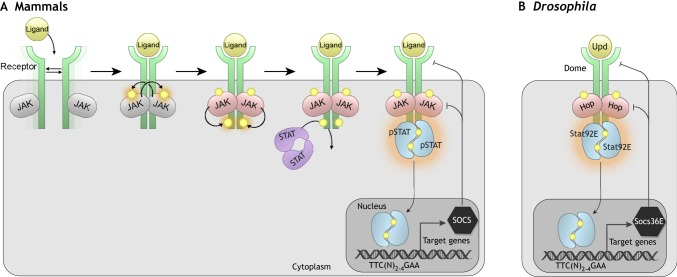Fig. 1.
The JAK/STAT pathway. (A) The mammalian JAK/STAT pathway. An extracellular ligand (yellow) binds to a transmembrane cytokine receptor (green), which lacks intrinsic kinase activity and instead constitutively associates with JAKs (gray). Ligand binding to receptors causes a conformational switch, leading to JAK activation by trans-phosphorylation. The activated JAKs (pink) then phosphorylate the receptor on tyrosine residues in the cytoplasmic domain. Inactive STAT dimers (purple) are recruited to the receptor at those phospho-tyrosine sites and are phosphorylated by activated JAKs. The phosphorylated STAT (pSTAT) dimers (blue) assume an activated dimer conformation, translocate to the nucleus, bind specific DNA sequences in target genes [consensus TTC(N)2–4GAA] and alter gene expression. SOCS genes, which are targets of the JAK/STAT pathway, encode inhibitory proteins (black) that promote degradation of the cytokine receptor and JAKs, thereby providing a negative-feedback loop. Tyrosine phosphorylation events are indicated by orange halos. (B) The Drosophila JAK/STAT pathway consists of three Upd ligands, Upd, Upd2 and Upd3 (referred to here collectively as Upd), one receptor called Dome, one JAK called Hop, and one STAT, termed Stat92E. Socs36E is a Stat92E target gene that encodes a negative regulator of pathway activity.

